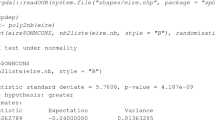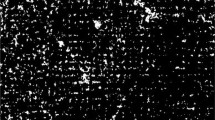Summary
This paper examines some of the possible reasons for discord between traditional tabular sorting and methods of numerical classification particularly in rainforest vegetation. A new method of numerical data organisation is introduced to avoid these problems which leads to a natural and operational definition of the Association. This definition relates the Association to the organisational level at which data structure changes from discontinuous to continuous. The method also establishes coefficients of constancy and dominance for species and permits numerical assessment of fidelity. An example is given of the application of the method to tropical rainforest vegetation in North Queensland.
Zusammenfassung
In dieser Arbeit werden einige der möglichen Gründe für die Diskrepanz zwischen den üblichen Tabellen-Ordnungsverfahren und numerischen Klassifikationsmethoden besonders in der Vegetation des tropischen Regenwaldes, untersucht.
Ein neues Verfahren für die Organisation numerischer Daten wird vorgeschlagen. Mit diesem Verfahren wird diese Diskrepanz vermieden und eine natürliche und operationelle Definition der Assoziation erreicht. Diese Definition verbindet die Assoziation mit dem Organisationsniveau auf welchem die Struktur der Daten von diskontinu in kontinu übergeht.
Das Verfahren stellt auch die Konstanz- und Dominanzkoeffizienten fest und ermöglicht eine numerische Schätzung des Treuegrads. Ein Beispiel der Anwendung dieses Verfahrens wird für tropische Regenwaldvegetation in North Queensland gegeben.
Similar content being viewed by others
References
Ashton, P. S. 1964. Ecological studies in the mixed Dipterocarp forests of Brunei State. Oxf. For. Mem. 25: 1–75.
Aubreville, A. 1938. La forêt coloniale: les forêts de l'Afrique occidentale française. Ann. Acad. Sci. Colon 9: 1–245.
Austin, M. P. & P. Greig-Smith. 1968. The application of quantitative methods to vegetation survey. II. Some methodological problems of data from rainforest. J. Ecol. 56: 827–844.
Braun-Blanquet, J. 1964. Pflanzensoziologie: Grundzüge der Vegetationskunde. 3. ed. Springer, Vienna-New York, 865 pp.
Češka, A. & H. Roemer. 1971. A computer program for identifying species/relevé groups. Vegetatio 23:255–277.
Curtis, J. T. & R. P. McIntosh. 1951. An upland forest continuum in the prairie forest border region of Wisconsin. Ecology 32: 476–496.
Dale, M. B. & D. J. Anderson. 1973. Inosculate analysis of vegetation data. Austral. J. Bot. 21: 253–276.
Dale, M. B. & L. Quadraccia. 1973. Computer-assisted tabular sorting of phytosociological data. Vegetatio 28: 57–73.
Fresco, L. F. M. 1971. Compound analysis: a preliminary report on a new numerical approach in phytosociology. Acta Bot. Neerl. 20: 589–599.
Hartigan, J. A. 1972. Direct clustering of a data matrix. J. Amer. Statist. Assoc. 67: 123–129.
Hill, M. O. 1973. Reciprocal averaging; An eigenvector method of ordination. J. Ecol. 61: 237–249.
Kruskal, J. B. 1964. Non-metric multidimensional scaling: a numerical method. Psychometrika 29: 115–129.
Lambert, J. M. & W. T. Williams. 1962. Multivariate methods in plant ecology. IV. Nodal analysis. J. Ecol. 50: 775–802.
Lambert, J. M. & W. T. Williams. 1966. Multivariate methods in plant ecology. IV. Comparison of information analysis and association analysis. J. Ecol. 54: 635–664.
Lance, G. N. & W. T. Williams. 1968. Note on a new information statistic classification program. Comput. J. 11: 195.
Lange, R. T. 1968. Influence analysis in vegetation. Austral. J. Bot. 16: 555–564.
Lieth, H. & G. W. Moore. 1970. Computerized clustering of species in phytosociological tables and its utilization in field work. In: Statistical Ecology 1, Spatial Pattern and Statistical Distributions, pp. 403–422, eds. G. P. Patil, E. C. Pielou & W. E. Waters.
Lieth, H., M. Numata & T. Suganuma. 1973. Studies in the grassland vegetation in the Kawatabi special research area of the Japanese I.B.P. Vegetatio 28: 41–56.
Maarel, E. van der, 1974. The Working Group for Data-Processing in Phytosociology of the International Society for Plant Geography and Ecology in 1972–1973. Vegetatio 29: 63–67.
Macnaughton-Smith, P. 1965. Some statistical and other numerical methods for classifying individuals. Home Office Research Unit Report No. 6, H.M.S.O. London.
Moore, J. J. (S. J.), P. Fitzsimmons, E. Lambe & J. White. 1970. A comparison and evaluation of some phytosociological techniques. Vegetatio 20: 1–20.
Noy-Meir, I. 1971. Multivariate analysis of the semi-arid vegetation of south-eastern Australia. I. Nodal ordination by component analysis. Proc. Ecol. Soc. Austral. 6: 159–193.
Noy-Meir, I. 1973. Divisive polythetic classification of vegetation data by optimizised division of ordination components. J. Ecol. 61: 753–760.
Poore, M. E. D. 1968. Studies in the Malaysian rainforest 1. The forest on Triassic sediments in Jengka forest reserve. J. Ecol. 56: 143–196.
Richards, P. W. 1952. The tropical Rain Forest. Cambridge University Press.
Schulz, J. P. 1960. Ecological studies on rainforest in Northern Surinam. Verh. K. Ned. Akad. Wet., Afd. Natuurk. 2. Sect. 53: 1–367.
Stanek, W. 1973. A comparison of Braun-Blanquet's method with sum of squares agglomeration for vegetation classification. Vegetatio 27: 323–345.
Tharu, J. & W. T. Williams. 1966. Concentration of entries in binary arrays. Nature Londen. 211: 549.
Webb, L. J., J. G. Tracey & W. T. Williams. 1972. Regeneration and pattern in rainforest. J. Ecol. 60: 675–695.
Webb, L. J., J. G. Tracey, W. T. Williams & G. N. Lance. 1967a. Studies in the numerical analysis of complex rainforest communities. I. A comparison of methods applicable to site/species data. J. Ecol. 55: 171–191.
Webb, L. J., J. G. Tracey, W. T. Williams & G. N. Lance. 1967b. Studies in the numerical analysis of complex rainforest communities. II. The problem of species sampling. J. Ecol. 55: 525–538.
Westhoff, V. & E. van der Maarel. 1973. The Braun-Blanquet approach. In: R. H. Whittaker (ed.). Handbook of Vegetation Science. Part V. Ordination and Classification of Communities, p. 617–726. Junk, The Hague.
Williams, W. T., J. M. Lambert & G. N. Lance. 1966. Multivariate methods in plant ecology. V. Similarity analysis and information analysis. J. Ecol. 54: 427–445.
Williams, W. T., G. N. Lance, L. J. Webb, J. G. Tracey & M. B. Dale. 1969a. Studies in the numerical analysis of complex rainforest communities. III. The analysis of successional data. J. Ecol. 57: 515–535.
Williams, W. T., G. N. Lance, L. J. Webb, J. G. Tracey & J. H. Connell. 1969b. Studies in the numerical analysis of complex rainforest communities. IV. A method for the elucidation of small scale forest pattern. J. Ecol. 57: 635–654.
Wishart, D. 1969. Mode analysis. In: Modern Methods in Numerical Taxonomy, pp. 282–308, A. T. Cole, ed. Academic Press, London & New York.
Author information
Authors and Affiliations
Additional information
Dedicated to Prof. J. Braun-Blanquet at the occasion of his 90th birthday
Nomenclature follows that currently accepted by the Botany Division of the Queensland Department of Primary Industry, formerly the Queensland Herbarium, Indooroopilly, Brisbane.
We gratefully acknowledge the cooperation of the Queensland Forestry Department in permitting access to the study areas. We also thank Mr. J. G. Tracey, C.S.I.R.O. Rain Forest Ecology Section, for assistance in the field survey and botanical identifications.
Rights and permissions
About this article
Cite this article
Dale, M.B., Webb, L.J. Numerical methods for the establishment of associations. Plant Ecol 30, 77–87 (1975). https://doi.org/10.1007/BF02389609
Accepted:
Issue Date:
DOI: https://doi.org/10.1007/BF02389609




